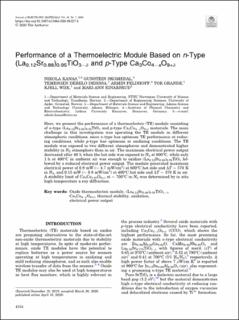| dc.contributor.author | Kanas, Nikola | |
| dc.contributor.author | Skomedal, Gunstein | |
| dc.contributor.author | Desissa, Temesgen D. | |
| dc.contributor.author | Feldhoff, Armin | |
| dc.contributor.author | Grande, Tor | |
| dc.contributor.author | Wiik, Kjell | |
| dc.contributor.author | Einarsrud, Mari-Ann | |
| dc.date.accessioned | 2020-09-29T08:32:38Z | |
| dc.date.available | 2020-09-29T08:32:38Z | |
| dc.date.created | 2020-09-22T15:10:26Z | |
| dc.date.issued | 2020 | |
| dc.identifier.citation | Journal of Electronic Materials. 2020, 49 4154-4159. | en_US |
| dc.identifier.issn | 0361-5235 | |
| dc.identifier.uri | https://hdl.handle.net/11250/2680162 | |
| dc.description.abstract | Here, we present the performance of a thermoelectric (TE) module consisting of n-type (La0.12Sr0.88)0.95TiO3 and p-type Ca3Co4-xO9+δ materials. The main challenge in this investigation was operation of TE module in different atmosphere conditions, since n-type has its optimum TE-performance at reducing, while p-type at oxidizing conditions. The TE module was exposed to two different atmospheres and demonstrated higher stability in N2 atmosphere than in air. The maximum electrical power output decreased after 40 h when the hot side was exposed to N2 at 600 °C, while only 1 h at 400 °C in ambient air was enough to oxidize (La0.12Sr0.88)0.95TiO3 followed by a reduced electrical power output. The module generated a maximum electrical power of 0.9 mW (~ 4.7 mW/cm2) at 600 °C hot side and ΔT ~ 570 K in N2, while 0.15 mW (~ 0.8 mW/cm2) at 400 °C hot side and ΔT ~ 370 K in air. A stability limit of Ca3Co3.93O9+δ at ~ 700 °C in N2 was determined by in situ high-temperature X-ray diffraction. | en_US |
| dc.language.iso | eng | en_US |
| dc.publisher | Springer Verlag | en_US |
| dc.rights | Navngivelse 4.0 Internasjonal | * |
| dc.rights.uri | http://creativecommons.org/licenses/by/4.0/deed.no | * |
| dc.title | Performance of a thermoelectric module based on n-type (La0.12Sr0.88)0.95TiO3-δ and p-type Ca3Co4-xO9+δ | en_US |
| dc.type | Journal article | en_US |
| dc.type | Peer reviewed | en_US |
| dc.description.version | publishedVersion | en_US |
| dc.source.pagenumber | 4154-4159 | en_US |
| dc.source.volume | 49 | en_US |
| dc.source.journal | Journal of Electronic Materials | en_US |
| dc.identifier.doi | 10.1007/s11664-020-08127-5 | |
| dc.identifier.cristin | 1832202 | |
| dc.relation.project | Norges forskningsråd: 228854 | en_US |
| dc.description.localcode | 2020 The Author(s). Open Access This article is licensed under a Creative Commons Attribution 4.0 International License, which permits use, sharing, adaptation, distribution and reproduction in any medium or format, as long as you give appropriate credit to the original author(s) and the source, provide a link to the Creative Commons licence, and indicate if changes were made. The images or other third party material in this article are included in the article's Creative Commons licence, unless indicated otherwise in a credit line to the material. If material is not included in the article's Creative Commons licence and your intended use is not permitted by statutory regulation or exceeds the permitted use, you will need to obtain permission directly from the copyright holder. To view a copy of this licence, visit http://creativecommons.org/licenses/by/4.0/. | en_US |
| cristin.ispublished | true | |
| cristin.fulltext | postprint | |
| cristin.qualitycode | 1 | |

